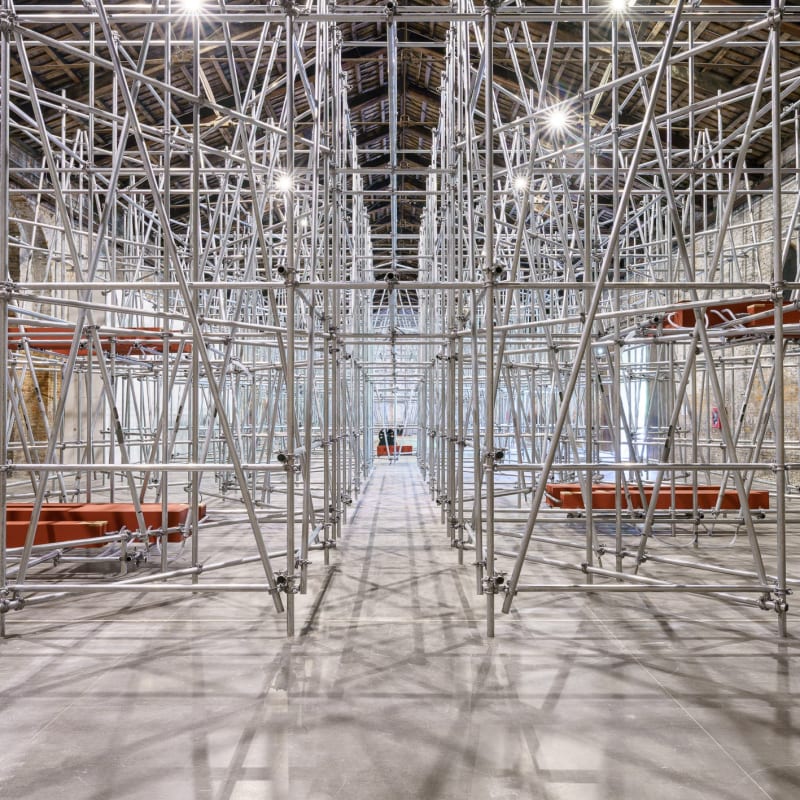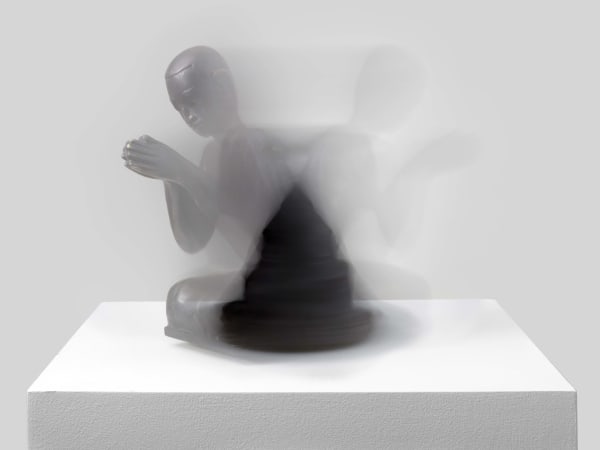Massimo Bartolini
The work of Massimo Bartolini (b. 1962, Cecina) conjures a particular energy between the gallery space and the viewer. Using both artificial and natural materials, he creates installations of heightened sensory intensity, interweaving sounds, images and light effects. He has created evocative spaces suffused with perfume, or others distorted by elevating the floor. Landscape is a recurring theme in his work – for the artist a landscape is a space of abstraction as much as nature, a site of meditation on permanence and impermanence. During an exhibition, the artist often transforms the gallery into a metaphorical landscape, permeated by cultural and biographical elements.
Water often features in Bartolini’s work – an element that symbolises for the artist the eternal renewal of life. Bartolini’s Dew series (2013–ongoing) are delicate abstractions, often marked by a horizon, that have a calm, almost monochrome appearance. Yet a closer inspection reveals a surface that the artist has treated with an artificial dew, giving the impression that the paint might evaporate – and the artwork transform – at any moment. Over the years Bartolini has developed installations that form a controlled wave, constantly in motion in a confined space. Untitled (Wave) (2000) was exhibited at MoMA PS1 and at Documenta 13, Conveyance (2003) was part of the solo presentation Hagoromo at Centro Pecci and Conveyance (2024) was displayed at the centre of the Italian Pavilion at the 60th Biennale di Venezia. Music is another recurring motif for the artist, manifested most ambitiously in the work Due qui (2024) for the Italian Pavilion. Taking the form of an immense organ constructed from scaffolding pipes, Bartolini collaborates with organ builders, technical experts and composers to create a unique immersive listening experience.
-

Massimo Bartolini
Book Launch at Centro Pecci, Italy 24 Nov 2022Thursday 24 November 2022, 6pm On Thursday 24 November Massimo Bartolini's new book will be launched at the Centro Pecci. The book accompanies the exhibition...Read more -

Words and Images
Online Viewing Room 25 Jan 202225 January–27 February 2022 To mark Shilpa Gupta’s links to language and poetry, exemplified by her large-scale sound installation For, In Your Tongue, I Cannot...Read more
-

Silver
17 Oct - 17 Dec 2014 Soho SquareSince opening, Frith Street Gallery has emerged as one of the art world’s most interesting forces, instrumental in developing the careers of internationally renowned figures as well as supporting those...Read more -

Massimo Bartolini
Afterheart 8 Feb - 28 Mar 2013 Golden SquareThe central work in the current exhibition, itself called Afterheart , is an acoustic sculpture. Here a scaled-up barrel, like that of a giant musical-box, slowly revolves, opening and closing...Read more -
 After the Volcano: A Summer Show of Gallery Artists 3 Jul - 14 Aug 2010 Golden SquareAfter the Volcano: a summer show of gallery artists features work by 14 gallery artists: Massimo Bartolini, John Riddy, Anna Barriball, Dayanita Singh, Dorothy Cross, Bridget Smith, Tacita Dean, Juan...Read more
After the Volcano: A Summer Show of Gallery Artists 3 Jul - 14 Aug 2010 Golden SquareAfter the Volcano: a summer show of gallery artists features work by 14 gallery artists: Massimo Bartolini, John Riddy, Anna Barriball, Dayanita Singh, Dorothy Cross, Bridget Smith, Tacita Dean, Juan...Read more -

Massimo Bartolini
2 May - 21 Jun 2008 Golden SquareHis works have included an elevated floor that created the impression of distorted space; an installation in which a device on the heel of a visitor’s shoes altered the light...Read more -

Resonance
The Final Exhibition at 59–60 Frith Street 3 Nov - 21 Dec 2006 Soho SquareFrith Street Gallery was established in 1989 with the intention of exhibiting drawings and works on paper. This exhibition recalls the gallery’s origins, bringing together works by gallery artists and...Read more -

Aligned
13 May - 25 Jun 2004 Soho SquareAligned brings together a group of artists working in a broad variety of disciplines and themes, yet for all of them the act of drawing remains at the core of...Read more -

Massimo Bartolini / Wiebke Siem
8 May - 21 Jun 2002 Soho SquareMassimo Bartolini ’s work embraces various materials and techniques, from sculpture and performance to photography. His often sensual artworks induce in the viewer a meditative state that is still highly...Read more

















